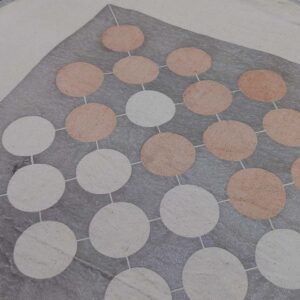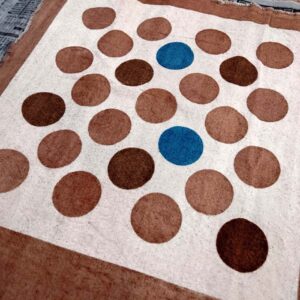先日にも紹介した“植物から得たタンニンで布を下染めし、媒染剤で反応させて異なった色を表現する染色技法”を研究しています。アフリカのボゴラン布や北インドのブロック・プリントなどが、そうした原理で染められていますが、ひとつ屋では日本の伝統的な糊を使った型染で、その表現にチャレンジしようと思っています。
ただ、おおよその原理はイメージできるのですが、くっきりとした柄を出しながら色を分け、さらに堅牢度を保つには、どうやら作業の順序が非常に大切なようです。順序を間違えると思ったような色が出ないことに気づきました。それが、今回の試し染めです。これはこれで気に入ってはいますが、もう少し研究の必要があるようです。
また、今回はワンポイントに藍染めを加えているのですが、これを染める方法から、化学染料が登場する前に日本で染められていた着物の染色技法にも私の興味は広がりつつあります。。まだまだ天然染料の研究を続けます! 楽しみにしていてください。
▼ 糊を置き、柿渋で染め始めた状態。


I’m researching a dyeing technique that I introduced the other day, in which tannins obtained from plants are used to undercoat the fabric and react with a mordant to express different colors. Bogolan cloth from Africa and block prints from North India are dyed using this principle, and I would like to challenge this expression with stencil dyeing using traditional Japanese glue.
However, I can imagine the general principle, but it seems that the order of the work is very important to separate the colors while producing a clear pattern and to maintain the fastness. I noticed that I didn’t get the colors the way I thought they would if I got the order wrong.That is the result of this trial dyeing that I uploaded. I like this one for now, but it looks like it needs a little more research.
In addition, since I added indigo dyeing to the one point this time, my interest is expanding from the method of dyeing this to the dyeing technique of kimono that was dyed in Japan before the appearance of chemical dyes. I will continue to research natural dyes! Please look forward to.
※ I am sorry that my English is so bad.
我正在研究前幾天介紹的一種染色技術,該技術使用從植物中獲得的單寧作為織物的底漆,並與媒染劑發生反應以呈現不同的顏色。 來自非洲的博戈蘭布和來自印度北部的版畫就是利用這一原理染色的,我想用傳統的日本膠水進行模版染色來挑戰這種表達方式。
然而,我可以想像一般原理,但似乎工作順序對於在產生清晰圖案的同時分離顏色並保持牢度非常重要。 我注意到,如果訂單錯誤,我得到的顏色就不會像我想像的那樣。這是我上傳的試染結果。 我現在喜歡這個,但看起來需要更多的研究。
另外,由於這次在其中加入了靛藍染色,所以我的興趣從這種染色方法擴展到了化學染料出現之前在日本染色的和服的染色技術。 我會繼續研究天然染料! 敬請期待。
*對不起,我的台灣語不好。